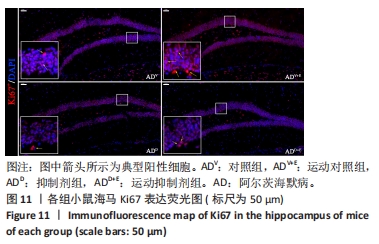[1] SCHELTENS P, DE STROOPER B, KIVIPELTO M, et al. Alzheimer’s disease. Lancet. 2021;397(10284):1577-1590.
[2] TATULIAN SA. Challenges and hopes for Alzheimer’s disease. Drug Discov Today. 2022;27(4):1027-1043.
[3] VAN DYCK CH, SWANSON CJ, AISEN P, et al. Lecanemab in Early Alzheimer’s Disease. N Engl J Med. 2023;388(1):9-21.
[4] YU W, WANG M, ZHANG Y. Construction of lncRNA-ceRNA networks to reveal the potential role of Lfng/Notch1 signaling pathway in Alzheimer’s disease. Curr Alzheimer Res. 2022. doi: 10.2174/1567205020666221130090103.
[5] CHAU DM, CRUMP CJ, VILLA JC, et al. Familial Alzheimer disease presenilin-1 mutations alter the active site conformation of γ-secretase. J Biol Chem. 2012;287(21):17288-17296.
[6] WOO HN, PARK JS, GWON AR, et al. Alzheimer’s disease and Notch signaling. Biochem Biophys Res Commun. 2009;390(4):1093-1097.
[7] 张业廷,李垂坤,魏翠兰,等. 有氧运动对阿尔茨海默症小鼠成年海马神经发生的影响[J].中国组织工程研究,2024,28(13):2068-2075.
[8] GHONEIM FM, KHALAF HA, ELSAMANOUDY AZ, et al. Protective effect of chronic caffeine intake on gene expression of brain derived neurotrophic factor signaling and the immunoreactivity of glial fibrillary acidic protein and Ki-67 in Alzheimer’s disease. Int J Clin Exp Pathol. 2015;8(7):7710-7728.
[9] SMITH TW, LIPPA CF. Ki-67 immunoreactivity in Alzheimer’s disease and other neurodegenerative disorders. J Neuropathol Exp Neurol. 1995;54(3):297-303.
[10] 张象,张业廷.运动改善阿尔茨海默症模型小鼠病程的剂量效应关系[J].中国组织工程研究,2021,25(17):2761-2766.
[11] ZHANG S, WANG P, REN L, et al. Protective effect of melatonin on soluble Aβ1-42-induced memory impairment, astrogliosis, and synaptic dysfunction via the Musashi1/Notch1/Hes1 signaling pathway in the rat hippocampus. Alzheimers Res Ther. 2016;8(1):40.
[12] BROWN BM, PEIFFER JJ, MARTINS RN. Multiple effects of physical activity on molecular and cognitive signs of brain aging: can exercise slow neurodegeneration and delay Alzheimer’s disease? Mol Psychiatry. 2013;18(8):864-874.
[13] YU Q, LI X, WANG J, et al. Effect of exercise training on long-term potentiation and NMDA receptor channels in rats with cerebral infarction. Exp Ther Med. 2013;6(6):1431-1436.
[14] ADLARD PA, PERREAU VM, POP V, et al. Voluntary exercise decreases amyloid load in a transgenic model of Alzheimer’s disease. J Neurosci. 2005;25(17):4217-4221.
[15] LIU HL, ZHAO G, ZHANG H, et al. Long-term treadmill exercise inhibits the progression of Alzheimer’s disease-like neuropathology in the hippocampus of APP/PS1 transgenic mice. Behav Brain Res. 2013;256:261-272.
[16] KANG EB, KWON IS, KOO JH, et al. Treadmill exercise represses neuronal cell death and inflammation during Aβ-induced ER stress by regulating unfolded protein response in aged presenilin 2 mutant mice. Apoptosis. 2013;18(11):1332-1347.
[17] ZALOULI V, RAJAVAND H, BAYAT M, et al. Adult hippocampal neurogenesis (AHN) controls central nervous system and promotes peripheral nervous system regeneration via physical exercise. Biomed Pharmacother. 2023;165:115078.
[18] PLANCHEZ B, LAGUNAS N, LE GUISQUET AM, et al. Increasing Adult Hippocampal Neurogenesis Promotes Resilience in a Mouse Model of Depression. Cells. 2021;10(5):972.
[19] KIM TA, SYTY MD, WU K, et al. Adult hippocampal neurogenesis and its impairment in Alzheimer’s disease. Zool Res. 2022;43(3):481-496.
[20] GAMBA P, TESTA G, GARGIULO S, et al. Oxidized cholesterol as the driving force behind the development of Alzheimer’s disease. Front Aging Neurosci. 2015;7:119.
[21] BASAK O, GIACHINO C, FIORINI E, et al. Neurogenic subventricular zone stem/progenitor cells are Notch1-dependent in their active but not quiescent state. J Neurosci. 2012;32(16):5654-5666.
[22] LI KX, LU M, CUI MX, et al. Astrocyte-neuron communication mediated by the Notch signaling pathway: focusing on glutamate transport and synaptic plasticity. Neural Regen Res. 2023;18(10):2285-2290.
[23] TIWARI SK, SETH B, AGARWAL S, et al. Ethosuximide Induces Hippocampal Neurogenesis and Reverses Cognitive Deficits in an Amyloid-β Toxin-induced Alzheimer Rat Model via the Phosphatidylinositol 3-Kinase (PI3K)/Akt/Wnt/β-Catenin Pathway. J Biol Chem. 2015;290(47):28540-28558.
[24] ALBERI L, HOEY SE, BRAI E, et al. Notch signaling in the brain: in good and bad times. Ageing Res Rev. 2013;12(3):801-814.
[25] CHEN CD, OH SY, HINMAN JD, et al. Visualization of APP dimerization and APP-Notch2 heterodimerization in living cells using bimolecular fluorescence complementation. J Neurochem. 2006;97(1):30-43.
[26] SWAMINATHAN B, YOUN SW, NAICHE LA, et al. Endothelial Notch signaling directly regulates the small GTPase RND1 to facilitate Notch suppression of endothelial migration. Sci Rep. 2022;12(1):1655.
[27] BRAI E, ALINA RAIO N, ALBERI L. Notch1 hallmarks fibrillary depositions in sporadic Alzheimer’s disease. Acta Neuropathol Commun. 2016; 4(1):64.
[28] FAZIO C, RICCIARDIELLO L. Inflammation and Notch signaling: a crosstalk with opposite effects on tumorigenesis. Cell Death Dis. 2016; 7(12):e2515.
[29] PAZOS MC, ABRAMOVICH D, BECHIS A, et al. Gamma secretase inhibitor impairs epithelial- to-mesenchymal transition induced by TGF-β in ovarian tumor cell lines. Mol Cell Endocrinol. 2017;440:125-137.
[30] AGUAYO-ORTIZ R, GUZMÁN-OCAMPO DC, DOMINGUEZ L. Toward the Characterization of DAPT Interactions with γ-Secretase. ChemMedChem. 2019;14(10):1005-1010.
[31] EVIN G, SERNEE MF, MASTERS CL. Inhibition of gamma-secretase as a therapeutic intervention for Alzheimer’s disease: prospects, limitations and strategies. CNS Drugs. 2006;20(5):351-372.
[32] HOOK VY, KINDY M, HOOK G. Inhibitors of cathepsin B improve memory and reduce beta-amyloid in transgenic Alzheimer disease mice expressing the wild-type, but not the Swedish mutant, beta-secretase site of the amyloid precursor protein. J Biol Chem. 2008;283(12):7745-7753.
[33] 陈玉晴. γ分泌酶抑制剂DAPT对海马突触传递和活性依赖可塑性的作用及其机制研究[D].上海:复旦大学,2013.
[34] 张业廷,魏翠兰,李垂坤,等.Notch1介导有氧运动改善阿尔茨海默病小鼠海马超微结构与空间记忆能力[J].中国康复医学杂志, 2023,38(7):885-897.
[35] LANZ TA, HIMES CS, PALLANTE G, et al. The gamma-secretase inhibitor N-[N-(3,5-difluorophenacetyl)-L-alanyl]-S-phenylglycine t-butyl ester reduces A beta levels in vivo in plasma and cerebrospinal fluid in young (plaque-free) and aged (plaque-bearing) Tg2576 mice. J Pharmacol Exp Ther. 2003;305(3):864-871.
[36] 陈天睿,黄雪媚,崔理立,等.治疗阿尔茨海默病的早老素/γ-分泌酶抑制剂和调节剂[J].生命科学,2009,21(4):508-512.
|














